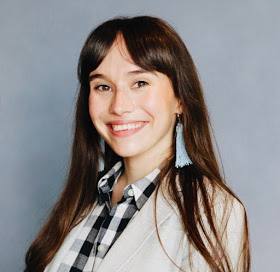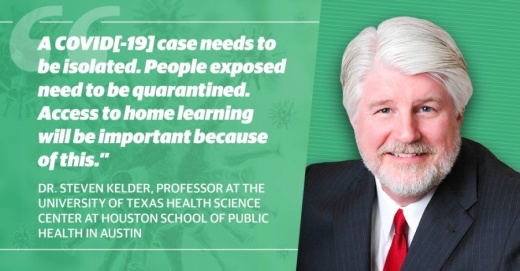Dr. Steven H. Kelder recently answered several questions for Community Impact Newspaper regarding COVID-19; trends in cases statewide; and important considerations for parents, students and educators as the 2020-21 school year approaches. Kelder is a Beth Toby Grossman Distinguished Professor in the Department of Epidemiology, Human Genetics, and Environmental Sciences at The University of Texas Health Science Center at Houston (UTHealth) School of Public Health in Austin with a career spanning more than 25 years
Answers have been lightly edited for length and clarity.
How should we interpret the seemingly decreasing death rate? We have read from other experts that the deaths tend to lag behind positive cases, but it would be helpful to hear from you about the severity of the virus and how we can understand data in that context.
The lag is caused by three factors. A: There really is a reporting delay from someone who is found positive, goes to [the] hospital, unfortunately succumbs, filling out [of the] death certificate, forwarding [the] health certificate to [the] health agency, and collation of the data and reporting. There can be a lag at each step. B: It could be that younger people are getting tested more frequently than before, which increases the denominator. When the denominator increases (the number of cases) and number of deaths stays the same (the numerator), then the rate can only go down. C: Clinical staff and hospitals are doing a better job. That is, people who end up in the hospital are getting cured rather than dying. At the beginning of the pandemic, medical personnel did not have as many treatment options as today. The health profession is past many parts of the learning curve.
Based on the trends you are seeing right now, how much danger is there that hospitals in major metropolitan areas in Texas will be overwhelmed soon?
That question has already been answered. Many [hospitals] are overwhelmed right now. I believe we have at least another month of increased cases, making school reopening in many districts a problem. Not everywhere in Texas is experiencing an increase, as Governor Abbott has said, but most urban and suburban areas are rising or holding steady at a high rate.
What kind of impact can reopening schools have on the larger community, especially since we are told children tend to be more asymptomatic carriers of coronavirus?
I worry more about the teachers. They are one of the rocks of any society, and they are heading into harm’s way. Let’s first remember to help them whenever we can. If a teacher becomes infected, there will be a lag time between getting the virus and the onset of symptoms. In addition, many people can be infected and [be] without any symptoms—especially younger adults. People who are asymptomatic may be spreading COVID[-19] without knowing it. That means there probably will be an outbreak amongst teachers, and many teachers are in the high-risk categories. That is, [people over] age 65, [those who are] diabetic, or [those with] lung and heart disease. Eight of 10 deaths are people over the age of 65. High-risk teachers need to be extra careful or reassigned to positions that do not require or have less public interaction.
Do certain school activities such as band or gym pose a higher health risk than other common school activities?
The most important areas of concern are social distancing, wearing a mask and monitoring symptoms or cases. If band or gym can do those things, I don’t think they will be at higher risk. In fact, if gym is outside, it’s safer as long as it doesn’t involve close competition. Choir might be a problem because vigorous singing can expel the virus. This is why masking is so important. Band [class] outside should be fine. Sharing instruments is not.
What is the latest information that is scientifically provable about the transmission of COVID-19 through the air? If there is nothing yet that is solidly proven, what can you say about new information that has come to light regarding airborne transmission?
We are still learning about COVID[-19] every day. A lack of proof doesn’t mean it doesn’t happen, and most experts believe COVID[-19] is spread through close contact with an infected person—mainly through the air.
If schools fully reopen in Texas as outlined in the Texas Education Agency's guidelines, how important is it that teachers, staff and students wear masks? Also, how enforceable/feasible is that?
There needs to be a combination of approaches. Social distancing is big. But if one can’t have the social distancing, then masking is even more important. It’s going to be difficult, and schools will need to stock masks for kids who forget them. Parents have to understand, too, that masking is not optional, especially when COVID[-19] rates are rising.
Provided we don’t see a working vaccine this year, is there a path to “normalcy” before 2021? Is there any possibility we will see a working and implemented vaccine before 2021?
I can’t really say about the vaccine. It’s not my area. But, from what I have heard, a vaccine this year is optimistic, and I don’t see normalcy until the 2021-22 school year. Even when a vaccine is found, there will be manufacturing and distribution problems that will linger for many month afterwards.
With regard to testing, why are there so many false results coming out still, and do you think there will be any kind of stark improvement in testing efficacy any time soon?
Improvements in the antibody testing is already here, and a much better test is being implemented by several companies. The antibody test is where the false positives were a problem. The new tests are not perfect, but much better.
As an epidemiologist, how do you think schools should implement the COVID-19 screening process provided schools fully open in August?
I don’t know. Funding is not available for free testing, plus many students don’t have insurance, and [insurance] won’t pay for testing unless the individual has symptoms. This is a political problem that needs to be solved. Other countries have done much more testing than the U.S. has. On a positive note, I can report that just last week I was asked to begin an effort with antibody testing for Texas teachers. I have about 20,000 free tests and will begin recruiting teachers in August on a first-come, first-serve basis. Twenty thousand test kits sounds like a lot, but there are hundreds of thousands of Texas teachers. It’s not enough, but it will give the individual some peace of mind and program planners a better estimate of the asymptomatic rate in Texas teachers.
How feasible is it to implement social distancing on campus? If children are encouraged to stay 6 feet apart from each other, should activities such as recess come to a halt or be modified in some way?
Recess and PE will be important, as kids have been cooped up for so long, and physical activity is so closely related to cognitive functioning. I’ve seen plans where kids are cohorted in class and at recess. That means the same group of students stay together all day. It’s challenging, especially in high school, where skills and interests are so varied, but I think schools will do their best to keep the kids safe. One overall point to make is that teachers and parents are stressed out about this fall. We have been told that schools will open, but I’ve heard that many parents are going to keep their kids at home for distance learning. This might provide some relief for schools that can’t house all the kids and maintain social distancing. I’ve also heard about teachers who are quitting, retiring or just plain overwhelmed and don’t know what to do. Creative solutions for staffing will be needed. I’m less concerned about kids for all the reasons that have been discussed in the media—lower rate of infection, less severe symptoms, quicker recovery and a question about whether they can transmit the disease. This varies with age, of course, where older high older school students are at high risk. We all have a role to play—districts, schools, students, parents, health personnel. Even a prepared school district will experience cases, and their prevention system will be stretched. Teachers and students will get sick. The virus can only do one thing, infect and replicate. This fall, we need to be vigilant, yet gracious and forgiving.






